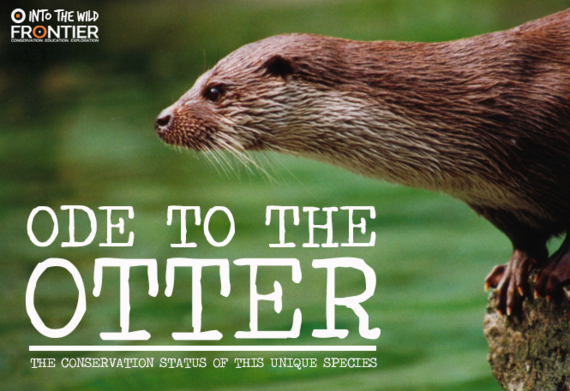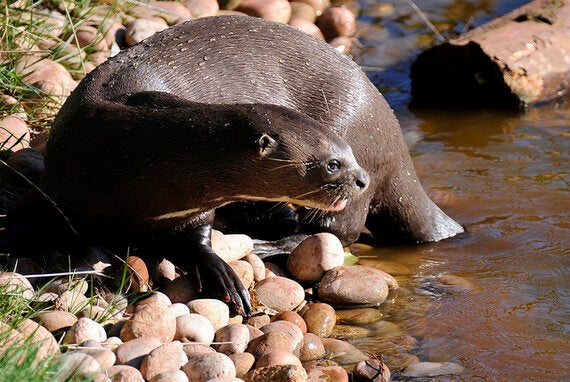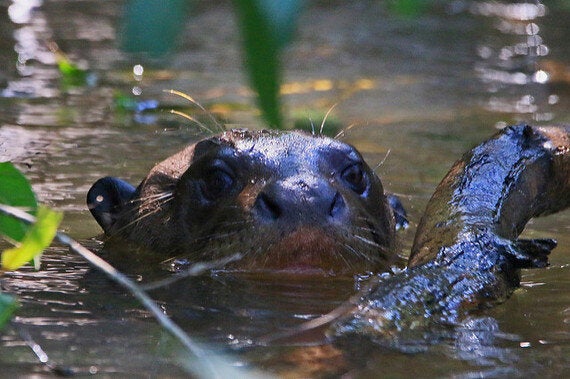
In the latest of a few species specific blog posts of late, we return to the 'Ode To The' theme for another of our 'O' friends. This time around, we're stopping and staring at the Giant Otter.
Otters have long been a great icon of British wildlife. They've lived for many years in our lakes, rivers and canals, but their popularity hasn't necessarily prevented them from being the victims of habitat loss of hunting. The story is the same around the world, which has led to the creation of a number of Otter based conservation projects.
Brazil is one such location. There, the Giant Otter is the resident sub-species, is the largest species of Otter and largest member of the weasel family too. Reaching a nearly unbelievable six feet in length, this staggeringly big otter has been listed as endangered for a number of years now.
Giant Otters are renowned for being pretty tough chaps, along with the rest of their species. There are stories from all over the world of them standing up against crocodiles and large birds of prey. This is hardly surprising from animals that eat piranhas, pikes and other predatory fish.

This ferocity and refusal to back down hasn't, however, kept the otter from the disruptive forces that shake the populations of so many other animals. The Giant Otter has been yet another victim of habitat loss. This is a particularly strong problem in South America, so much of which revolves around the Amazon basin, a hive of habitats, species, eco-systems and diversity that is surely a paradise if left alone. However, this diversity has too attracted the eye of industry, as it is an unmissable goldmine of recourses. The Giant Otter, along with so many others, has therefore been a victim of logging and deforestation, along with poaching for furs.
In addition, the giant otter can be used as a marker for the eco-system in which it lives over all, being an apex predator and their gradual decline in recent decades directly correlates to the gathering speed of the Amazon's decline.
It goes without saying that the plight of the Giant Otter is becoming drastic. In response, conservation
efforts have stepped up, not just in Brazil for the Giant Otter, but globally for all the different subspecies.
Here too in the U.K, where the otter is so beloved, attention has been turned towards them to save and restore their populations. Cordoning off areas of national park or wildlife reserve has been a big step forward, where more and more areas of land are given over to nature in order to give the otter and other species' a safe haven in which to prosper. They also run into trouble with agriculture, as their habitats often come into close proximity with farmland which can be highly disruptive to their feeding and living requirements. Otters have been protected under law since the 80's too, but their numbers in U.K are only just starting to stabilise after a steep decline.

In Brazil, the story is much the same, just catching up by a few years. The current estimation is that there are only somewhere between one and five thousand Giant Otters left in the wild. There are however a large number in captivity, which could help re-establish the wild populations.
The threats to the Giant Otter aren't just loss of habitat however. Over fishing in the Amazon has led to depleted food sources for the Otter, who have to complete with a wide variety of other predators for the fish supplies. Quite a unique threat too is the extensive gold mining industry that takes place in numerous locations around the Amazon. As a result of this process, huge amounts of mercury are dumped or leaked into the river systems. Mercury is used in the process of gold mining but is a waste material of the process. A highly toxic and pollutant metal, it contaminates animal and vegetation supplies in the area, again reducing the necessary recourses the Giant Otter relies on.
This gold mining industry is an under the radar threat to the amazon, one that is only just starting to be recognised for the damage it is and has been doing.

In practical terms, Brazil is leading the way with conserving the Giant Otter, with new conservation projects springing up fast. These projects working on everything from breeding programmes to protecting and restoring environment conditions, education in local schools and organisations so that the word is spread about protecting the animals and lobbying to legislate protection nationally.
This is what the new Frontier Otter Sanctuary and Conservation project is aimed at in Brazil. This project works hands on with scientific research of the environment and the animals to put together a more detailed and effective game plan for saving them.
Otters of all types are just one of those animals that we humans love, even if, when asked about their favourite animals, most people won't immediately think of them. Beyond that, they are some of the most important apex predators alive as they inhabit some of the most complex and diverse eco-systems on the planet. The Amazon and Giant Otter is a prime example, being the apex predator in arguably the world's most diverse environment.
They are vital to their environment, which is good enough reason to help conserve them, along with the added reason of us humans having a soft spot for them.
For more information about the Frontier Brazil Otter Sanctuary and Conservation Project, visit this link.
By Guy Bezant - Online Journalism Intern
Frontier runs conservation, development, teaching and adventure travel projects in over 50 countries worldwide - so join us and explore the world!
See more from our volunteers #Frontiervolunteer
